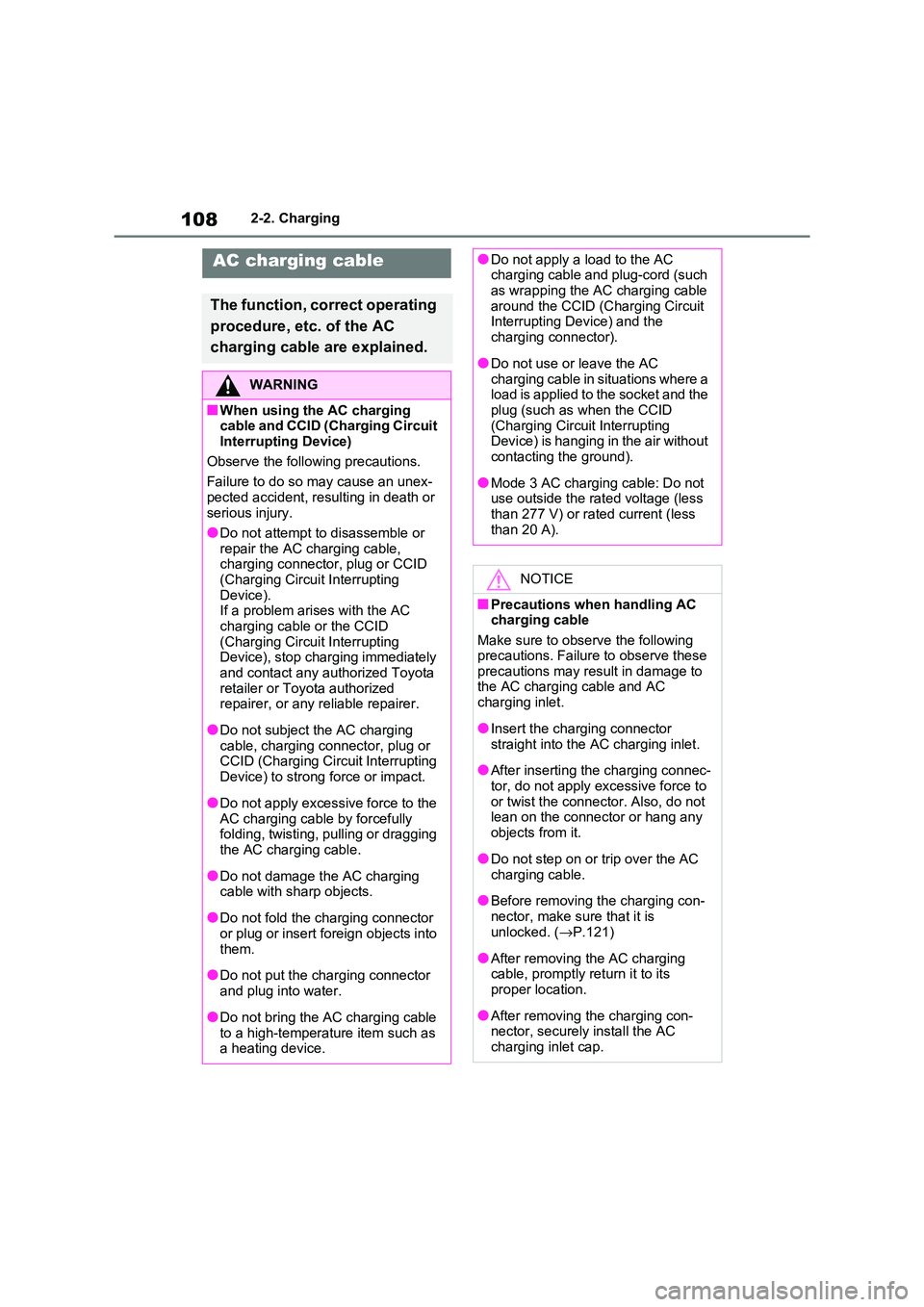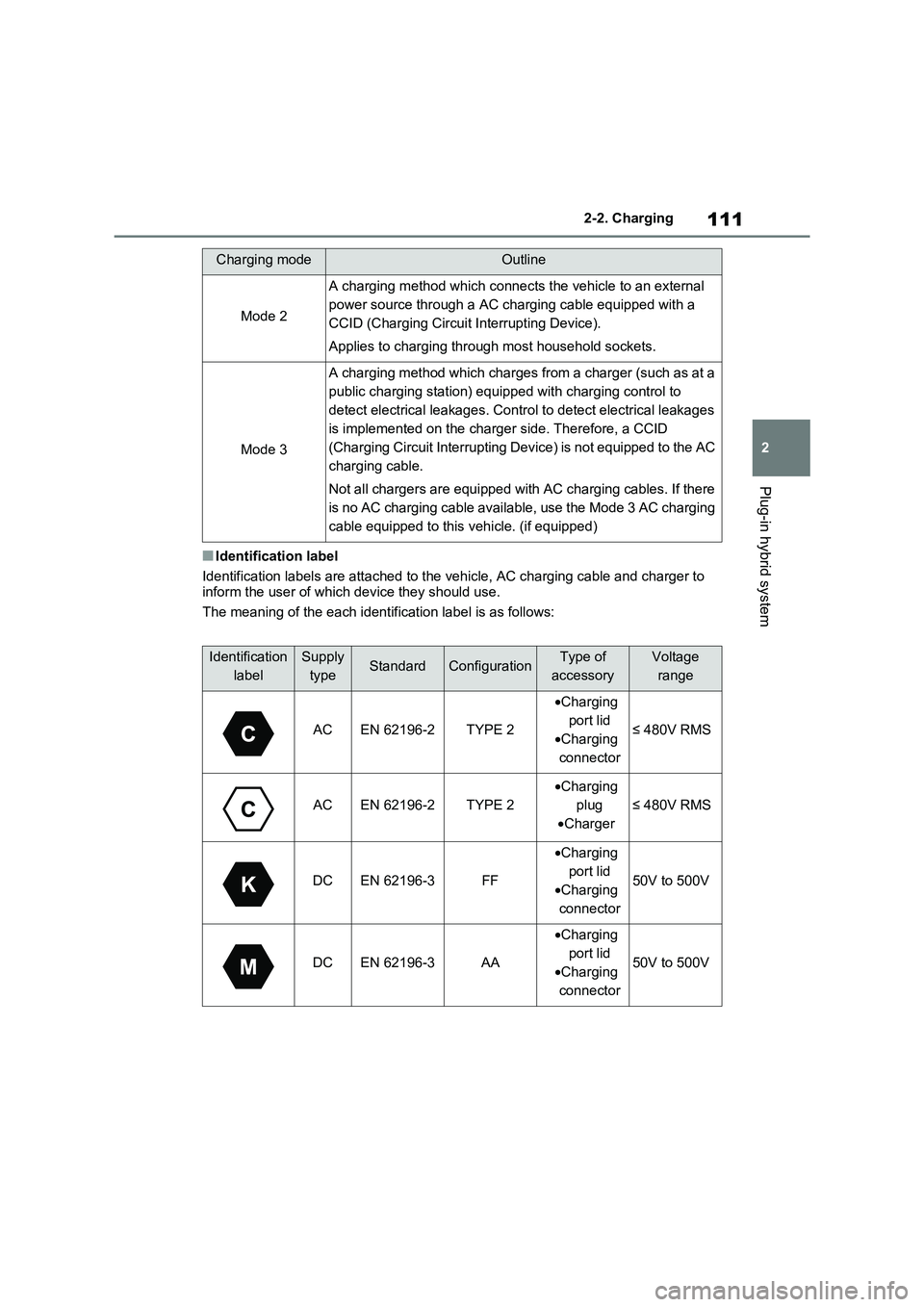Page 106 of 666

1042-1. Plug-in hybrid system
A pressure level 50 kPa (0.5 kgf/cm2 or
bar, 7 psi) lower than the specified
value will cause a worsening of several
percentage points.
■When driving on highways,
use the EV/HV mode selection
switch to drive in HV mode
The power consumption will
increase significantly if the vehicle
is driven in EV mode on highways.
■Do not load unnecessary
objects in the vehicle
Driving with objects weighing 100
kg (220 lb.) in the vehicle will
worsen the electrical and fuel effi -
ciency by approximately 3%.
Air resistance also greatly affects
electrical and fuel efficiency.
Remove any exterior accessories
such as a roof luggage carrier when
they are not being used.
The running resistance of snow
tires is high and they will worsen
electrical and fuel efficiency.
Replace them with standard tires
as soon as they are no longer
needed.
■Know your vehicle’s electrical
and fuel efficiency
If you know your vehicle’s daily
electrical and fuel efficiency, you
will understa nd the benefits of Eco
drive.
Use the Power Consumption/Fuel
Economy, ECO Accelerator Guid -
ance/“Eco Score” and other data
displayed on the multi-information
display.
The following indicate that charging
has been carried out properly.
The charging indicator of the
charging port turns off
“Charging Complete” is dis-
played on the multi-information
display when a door is opened
with the power switch off
( →P.131)
Regardless of the type of power
source or whether the charging
schedule function is used, charging
is completed if the above can be
confirmed.
Charging-related messages: →P.160
Display when charging is
completed
Page 107 of 666
105
2
2-2. Charging
Plug-in hybrid system
2-2.Charging
AC charging inlet
AC charging inlet light
Charging indicator ( →P.106)
AC charging inlet cap
Caution label/identification label
Charging port lid ( →P.106)
AC charging cable* ( →P.108)
Charging port
*: The number of equipped AC chargin g cables may differ depending on the target
region.
Charging equipment
This vehicle features equipment for connecting to an external
power source.
Charging equipment and names
A
B
C
D
E
F
G
H
Page 108 of 666
1062-2. Charging
■Opening the charging port lid
Press the central rear edge of the
charging port lid (the location
shown in the illust ration) with the
doors unlocked.
Push and take your hand away to
slightly open the charging port lid. Then
open the lid fully by hand.
■Closing the charging port lid
Close the charging port lid and
press the central rear edge of the
charging port lid (the location
shown in the illustration).
When the doors are locked, the
charging port lid i s also locked.
( →P.121)
The illumination/flashing pattern changes to inform the user of the charging
status in the following ways.
Opening and closing the
charging port lid
Charging indicator
Page 109 of 666

107
2
2-2. Charging
Plug-in hybrid system
*: Flashes for a certain period of time, and then turns off.
■Charging indicator of the charging port
When a system mal function occurs while charging or using the Remote Air Condi-
tioning System, the charging indicator rapidly flashes for a ce rtain period of time, and then turns off.
If this occurs, when a door is o pened with the power switch off, a message is dis-
played on the multi-information display. When a message is displayed, follow the instructions displ ayed on the screen.
Illumination/flashing patternVehicle condition
Illuminated
•Charging is in progress
• Charging is possible
• “Battery Heater” (→P.128) is operating
• “Battery Cooler” (→P.129) is operating
Flashing (normally)*When charging schedule is registered (→P.144) and
AC charging cable is c onnected to vehicle
Rapidly flashing*When charging cannot be carried out due to malfunc-
tion in a power source or the vehicle etc. (→P.158)
Not illuminated
•Charging connector is not inserted into AC
charging inlet
• When the charging schedule (→P.144) is on
standby
• When charging is completed
Page 110 of 666

1082-2. Charging
AC charging cable
The function, correct operating
procedure, etc. of the AC
charging cable are explained.
WARNING
■When using the AC charging
cable and CCID (Charging Circuit
Interrupting Device)
Observe the following precautions.
Failure to do so may cause an unex -
pected accident, resulting in death or serious injury.
●Do not attempt to disassemble or
repair the AC charging cable, charging connector, plug or CCID
(Charging Circuit Interrupting
Device). If a problem arises with the AC
charging cable or the CCID
(Charging Circuit Interrupting Device), stop charging immediately
and contact any authorized Toyota
retailer or Toyota authorized repairer, or any reliable repairer.
●Do not subject the AC charging cable, charging connector, plug or
CCID (Charging Circuit Interrupting
Device) to strong force or impact.
●Do not apply excessive force to the
AC charging cable by forcefully folding, twisting, pulling or dragging
the AC charging cable.
●Do not damage t he AC charging
cable with sharp objects.
●Do not fold the ch arging connector
or plug or insert foreign objects into
them.
●Do not put the ch arging connector
and plug into water.
●Do not bring the AC charging cable
to a high-temperature item such as a heating device.
●Do not apply a load to the AC charging cable and plug-cord (such
as wrapping the AC charging cable
around the CCID (C harging Circuit Interrupting Device) and the
charging connector).
●Do not use or leave the AC
charging cable in situations where a
load is applied to the socket and the plug (such as when the CCID
(Charging Circui t Interrupting
Device) is hanging in the air without contacting the ground).
●Mode 3 AC charging cable: Do not use outside the ra ted voltage (less
than 277 V) or rated current (less
than 20 A).
NOTICE
■Precautions when handling AC charging cable
Make sure to observe the following
precautions. Failure to observe these precautions may result in damage to
the AC charging cable and AC
charging inlet.
●Insert the charging connector
straight into the AC charging inlet.
●After inserting th e charging connec-
tor, do not apply excessive force to or twist the connec tor. Also, do not
lean on the connector or hang any
objects from it.
●Do not step on or trip over the AC
charging cable.
●Before removing the charging con -
nector, make sure that it is unlocked. ( →P.121)
●After removing the AC charging cable, promptly return it to its
proper location.
●After removing the charging con -
nector, securely install the AC
charging inlet cap.
Page 111 of 666
109
2
2-2. Charging
Plug-in hybrid system
Mode 2 AC charging cable
Charging connector
Identification label
Plug
Plug-cord
NOTICE
■When using the AC charging
cable and related parts
→ P.135
■Precautions for low tempera-
tures
In low temperatures, the AC charging
cable and plug-cord may become
hard.
Therefore, make su re to not apply excessive force when they are hard. If
excessive force is applied to the hard -
ened AC charging cable and plug- cord, they may be damaged.
The names of each part of the AC charging cable
A
B
C
D
Page 112 of 666
1102-2. Charging
CCID (Charging Circuit Interrupting Device)
Power indicator ( →P.113)
Charging indicator ( →P.113)
Error warning indicator ( →P.113)
Mode 3 AC charging cable (if equipped)
Charging connector (vehicle side)
Identification label (on the charging connector)
Charging plug (charger side)
Identification label ( on the charging plug)
■AC charging cable types
The following charging modes are categorized according to the availability of a charging control device, which detects malfunctions such as ele ctrical leakages, and
its location (whether it is attach ed to the charger or AC charging cable). The type of
AC charging cable that can be us ed differs according to the charging mode
Charging modeOutline
Mode 1
A charging method which does not use charging control to
detect electrical leakages bet ween an external power source
and the vehicle. Does no t apply to this vehicle.
E
F
G
H
A
B
C
D
Page 113 of 666

111
2
2-2. Charging
Plug-in hybrid system
■Identifica tion label
Identification labels are attac hed to the vehicle, AC charging cable and charger to inform the user of which device they should use.
The meaning of the each identif ication label is as follows:
Mode 2
A charging method which connects the vehicle to an external
power source through a AC c harging cable equipped with a
CCID (Charging Circuit Interrupting Device).
Applies to charging through most household sockets.
Mode 3
A charging method which charges from a charger (such as at a
public charging station) equip ped with charging control to
detect electrical leakages. Control to detect electrical leakag es
is implemented on the charge r side. Therefore, a CCID
(Charging Circuit Interrupting Device) is not equipped to the A C
charging cable.
Not all chargers are equipped with AC charging cables. If there
is no AC charging cable available, use the Mode 3 AC charging
cable equipped to this vehicle. (if equipped)
Identification
label
Supply
typeStandardConfigurationType of
accessory
Voltage
range
ACEN 62196-2TYPE 2
• Charging
port lid
• Charging
connector
≤ 480V RMS
ACEN 62196-2TYPE 2
• Charging
plug
• Charger
≤ 480V RMS
DCEN 62196-3FF
•Charging
port lid
• Charging
connector
50V to 500V
DCEN 62196-3AA
• Charging
port lid
• Charging
connector
50V to 500V
Charging modeOutline